
Cambodia is best known for its historic temple ruins, most notably Angkor Wat, as well as the scars left by the mass genocide carried out by the ruthless Khmer Rouge Communist Party in the late 1970s. The country also offers many beautiful destinations including lakes, rivers, and misty mountains.
However, the very best of Cambodia is the coastal region along the Gulf of Thailand, home to authentic fishing villages and some of Asia’s most unspoiled paradise islands with long white beaches and crystal clear turquoise waters.
Come along as we explore Cambodia’s tropical south in two posts: This post – the Coastal Towns, and another post – the islands of Cambodia.
Why Travel to Cambodia’s Coastal Towns?
- The Low-Down: The southern part of Cambodia is rich in history, in particular from its French colonial past. While time has not been standing still here, towns such as Kampot and Kep are still cosy, quaint, and welcoming. Stay a few days or a few months as the tranquillity will suck you in!
- The Brightest Highlight: Driving by motorbike or bicycle from Kampot up to Bokor Mountain Plateau to the Preah Monivong Bokor National Park is a must-do. The park is home to thick jungles, wildlife, and the old French Hill Station. Here you can explore many old ruined villas that once served as residences, luxury resorts, and retreats to the colonial high-class during the early 1920s. Swaying in your hut’s hammock on the banks of the Preaek Tuek Chhu River, north of Kampot, should not be missed.
- Intrepid Destination: If you visit during the week and off-season, you will have much of the area to yourself.
- GlobeRovers Score (10 is highest): A great place to spend a few days before heading over to Cambodia’s idyllic islands. I’ll score it 8.2 out of 10.
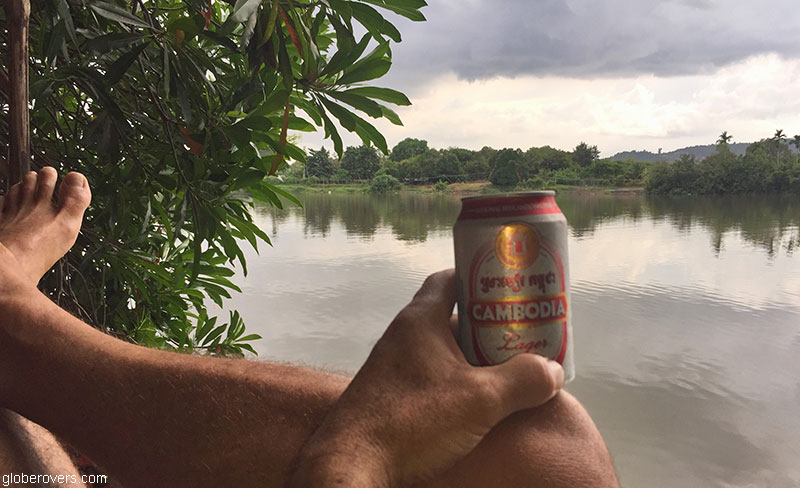
Table of Contents
Welcome to Cambodia
Frank Vincent Jr. offered a colourful rendition of his first visit to Cambodia in the 1878 issue of the “Journal of American Geographical Society of New York”. His visit was inspired while in Singapore in 1871 after hearing “detailed descriptions of the wonderful ruins in Cambodia”. The following year Frank visited and described Cambodia as follows: “There are also ruins of temples, monasteries and palaces; and, indeed, the whole valley of the Mekong River to the very borders of China is spread with ruins of more or less magnitude, beauty and interest”.
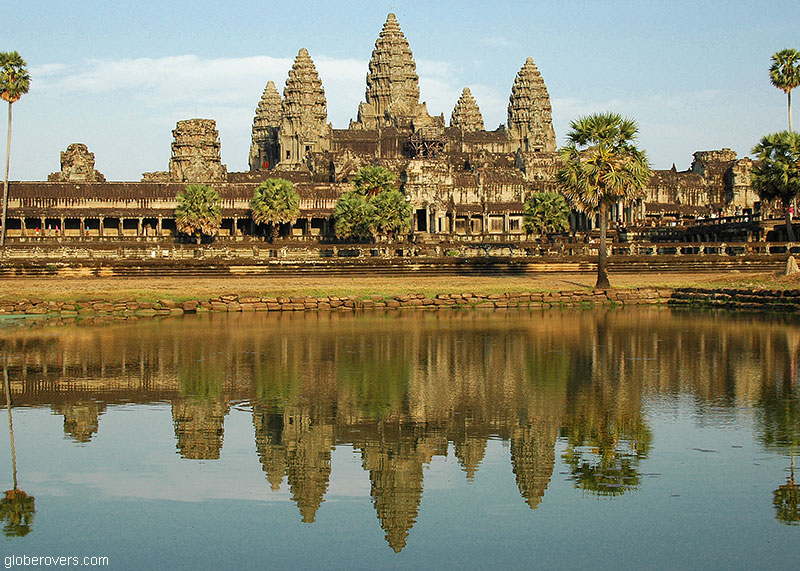
In the years following Frank’s expeditions, many more ruins were discovered and made accessible to future travellers.
More recently, in 2016, the Smithsonian Magazine reported “a lost city found in Cambodia” and wrote: “Deep in the jungles of Southeast Asia, archaeologists have rediscovered the remains of an invisible kingdom that may have been the template for Angkor Wat”. This temple might have been the “mother of the Angkor Wat”, Cambodia’s most famous and popular temple which has been described as the largest religious monument in the world.
Cambodia’s coastal region along the Gulf of Thailand is home to authentic fishing villages and some of Asia’s most unspoiled paradise islands with long white beaches and crystal clear turquoise waters.
The Angkor temple complex was constructed by the Khmer King Suryavarman II in the early 12th century as his state temple and eventual mausoleum. In 2019, the temple attracted about 2.2 million foreigners plus many domestic tourists. Ticket sales to the foreigners amounted to over $99 million.

Angkor Wat is obviously popular and on the bucket list of many world travellers, particularly those interested in history, Asian religion, and ancient ruins. Sadly, for most travellers, Angkor Wat is their only reason for visiting Cambodia. They view Cambodia as merely a detour from their extensive travels through Thailand to the west and Vietnam to the east.
While Angkor Wat is magnificent, there is so much more to Cambodia.
Cambodia emerged from the ruthless rule of communist dictator Pol Pot, leader of the Khmer Rouge Communist Party, who carried out a mass genocide from 1975 to 1979, killing more than two million people.
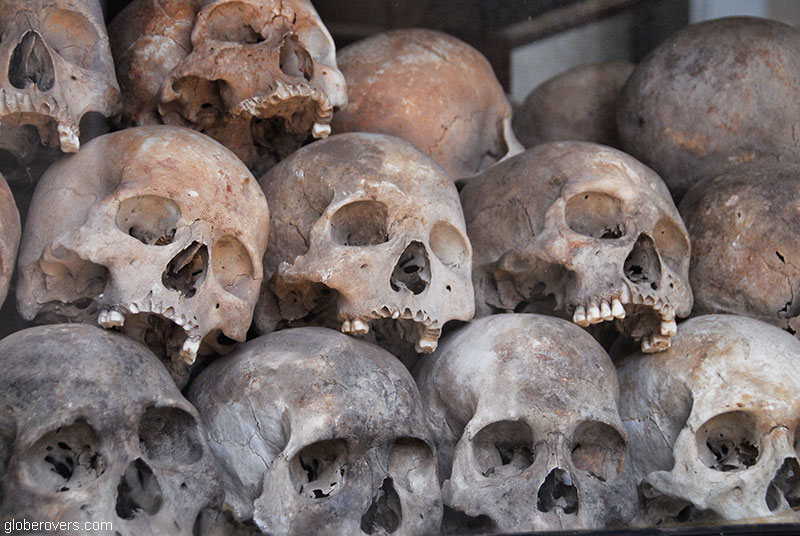
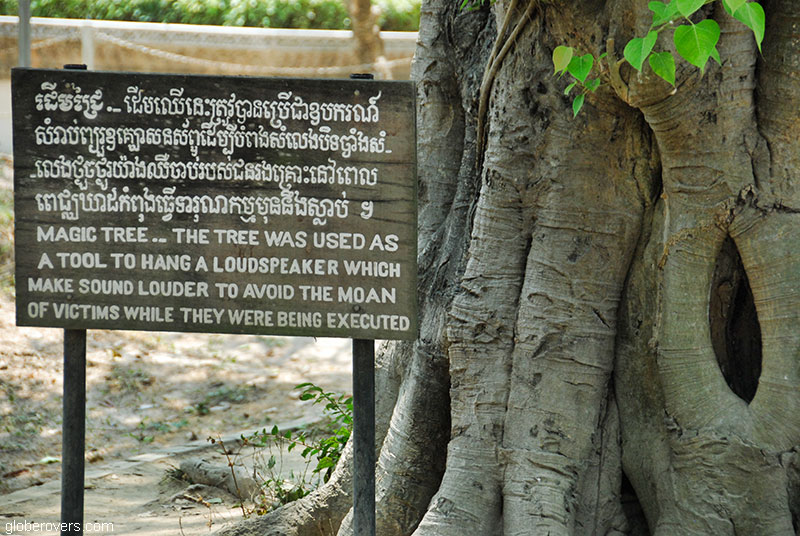
Today there are still a few places in and around the capital, Phnom Penh, to learn about this dark period of the nation’s history.
Not to miss is Phnom Penh’s Tuol Sleng Genocide Museum housed within a high school that the Khmer Rouge converted into the notorious Security Prison 21, commonly known as the “S-21 Prison”. Outside Phnom Penh are the Choeung Ek Killing Fields, site of over 17,000 executions of men, women, and children.
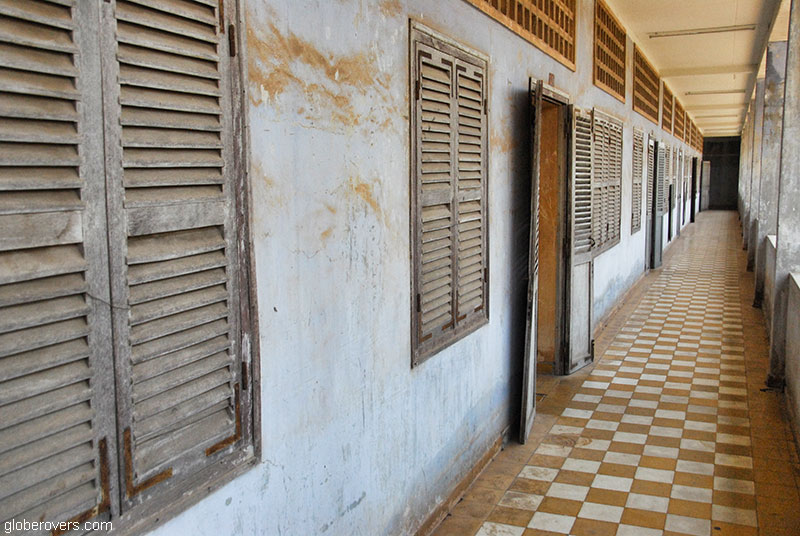
Phnom Ta Reach, located at Phnom Touch village 101 kilometres (63 miles) from Phnom Penh, was where the Khmer Rouge ordered prisoners to carve a tunnel through a rocky mountain over 200 metres (656 feet) long, 2.8 metres (nine feet) wide and six metres (20 feet) high.
But Cambodia is a lot more than historic temple ruins and remnants of a mass genocide.
Other must-visit destinations include the beautiful Mondulkiri Province in the east of the country along the Vietnam border, known for its hardy Bunong people and their noble elephants, and the Krâvanh (Cardamom) Mountains in the southwest with one of the last unbroken rainforests in Asia.
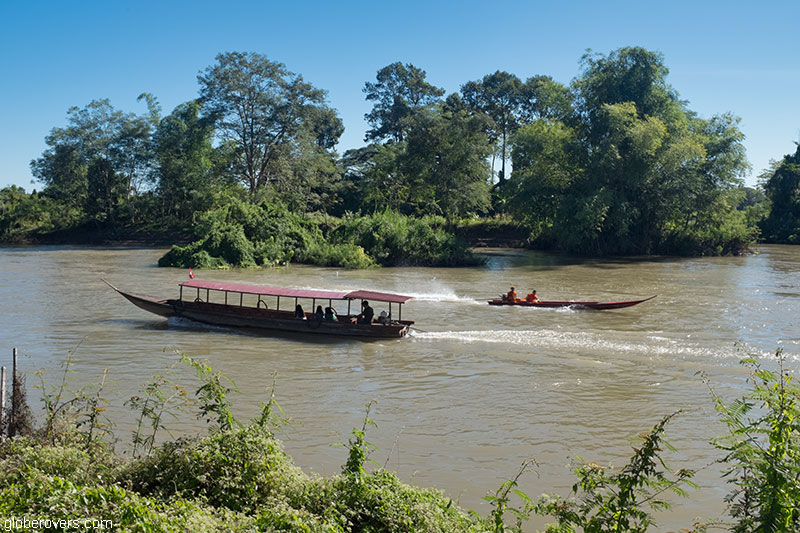
There’s also the floating and stilted villages along the shores of Tonle Sap, the largest freshwater lake in Southeast Asia, which offer a glimpse into the lives of these fascinating people.
Unquestionably, one of the best destinations of Cambodia is the coastal region along the Gulf of Thailand that is home to many authentic fishing villages and some of Asia’s most unspoiled paradise islands with long white beaches and crystal clear waters.
Cambodia’s coastal region is slated for major development as investors from China are rapidly moving in to transform this part of the country. The town of Sihanoukville has been a construction site for the last few years, and developers also have their eyes on the nearby islands. Now is the time to explore the area before it changes too much.

We start our journey in the small coastal town of Kep, known for its blue sea crabs fried with fresh local peppercorns.
Next is the town of Kampot and its peaceful countryside as well as nearby Bokor National Park, before we again head out on a boat to soak up the sun on Cambodia’s most beautiful islands: Koh Tonsai, Koh Russey, Koh Rong, and Koh Rong Sanloem. For too long these islands have been overlooked by many international travellers in the region. (See the blogpost of Cambodia’s Islands).
While tourist arrivals are slowly increasing, parts of these islands still remain undeveloped with long pristine beaches and rustic Khmer villages.
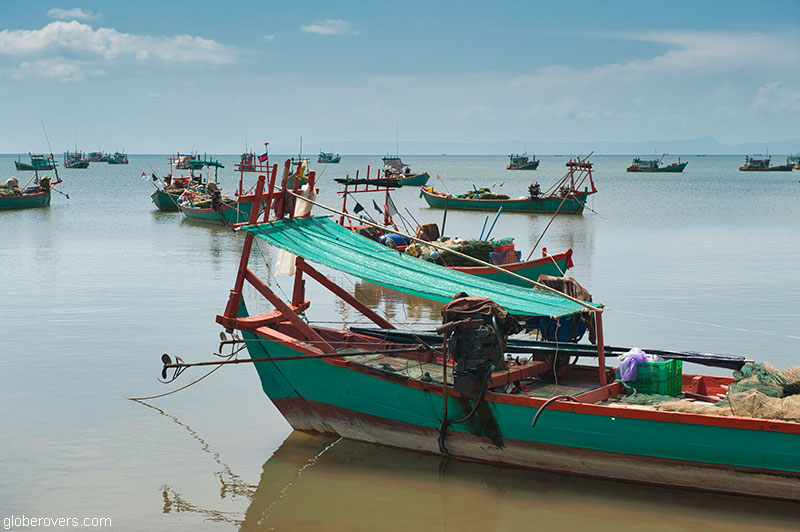
The Town Of Kep
Founded in 1908 during the time of the French colonization, Kep was known as Kep Sur Mer, with “Kep” derived from the French le cap meaning ‘cape’ in English. Located 100 kilometres (62 miles) east of Sihanoukville International Airport, and 167 kilometres (104 miles) south of Phnom Penh, the Cambodian capital, the town of Kep has been beloved by Cambodians for generations.
The sea crab capital of Cambodia is also known for its abandoned villas.
However, Kep once was reserved as an exclusive seaside getaway for the colonial French bourgeois elite and the wealthy high ranking Khmer leaders who liked to mingle with the colonialists.
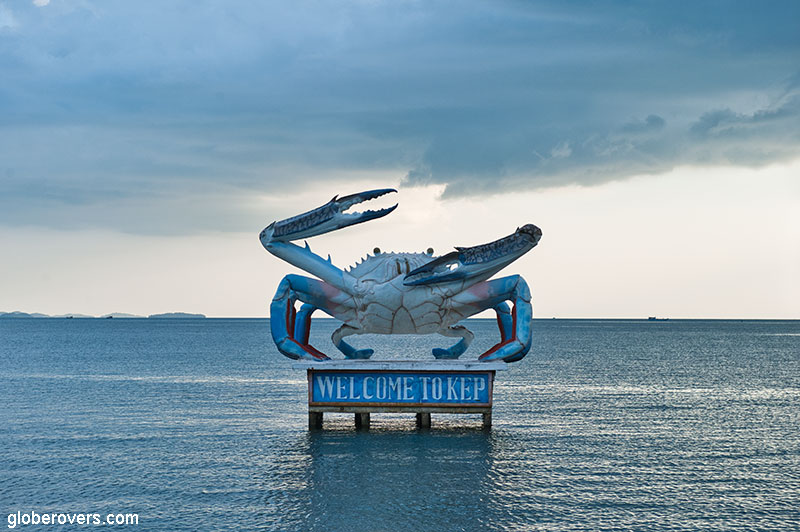
A flamboyant past, followed by a dark time of destruction, Kep has now inadvertently become famous for its abandoned stately villas that were built during the Golden Age of Cambodia of the 1950s and early 1960s. Since the end of the colonial days in 1953, the country has been ravaged during the Civil War (1967 – 1975) and the subsequent brutal rule of the Khmer Rouge regime (1975 to 1979).
The villas suffered badly during the fighting and were looted by the Khmer Rouge and the Vietnamese. Today, the spooky old villas have become somewhat of a tourist attraction, while mostly shunned by locals who believe the buildings are haunted.
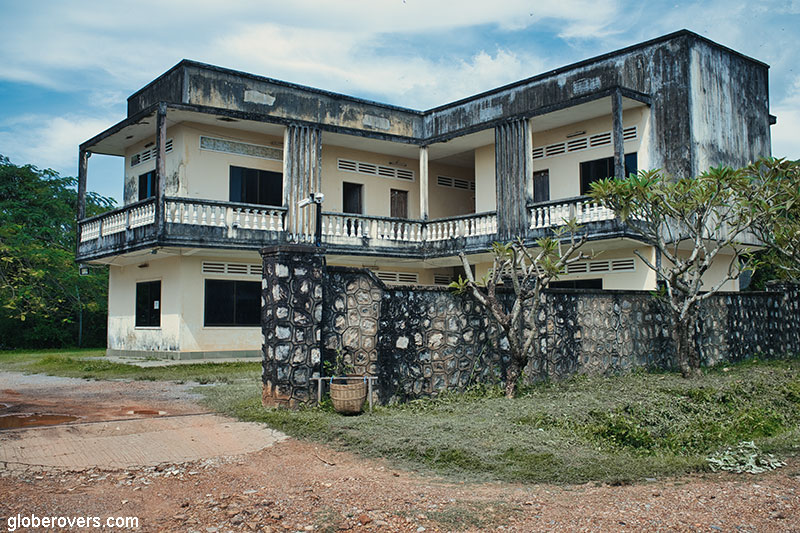
Don’t miss the Queen’s Villa, one of the abandoned buildings on the beachfront near the Koh Tonsay boat terminal. Built in the 1930s, it was designated as a residence of Queen Sisowath Kossamak (b:1904 – d:1975). Not far from here, near the top of the hill, are the ruins of the unfinished palace of her son, Norodom Sihanouk (b:1922 – d:2012), Cambodia’s mercurial and artistic Prince, King, Prime Minister, and “Protector of Cambodia”. Referred to as the “Queen’s Palace,” this mansion was never completed and Norodom never lived here.
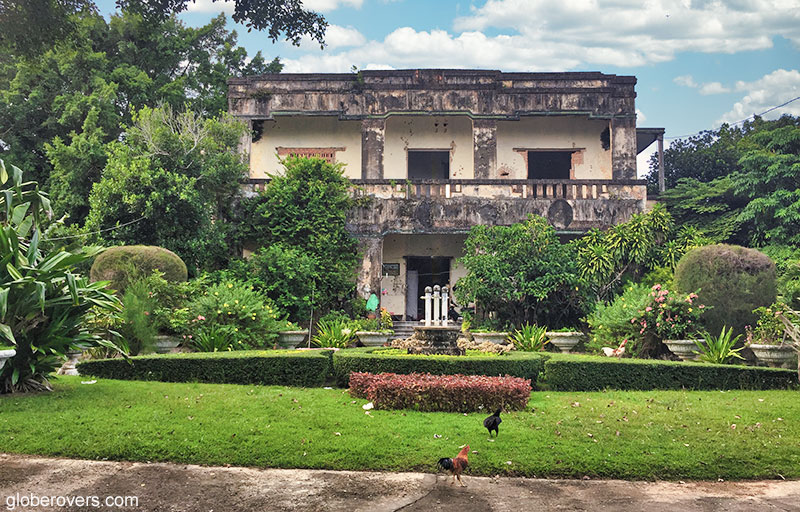
These days, many Cambodians flock to this popular seaside holiday spot for one reason: Kep’s blue crabs. In the early mornings, the seafood market along the main beach is a hive of activity as people scramble to buy fresh crabs.
Next to the market is a row of shacks selling the eponymous dish, which usually comes stir-fried with an ample amount of locally grown peppercorns. On weekends and holidays, the shady areas along the beach are crowded with families enjoying their picnics, each with plenty of fried crabs.
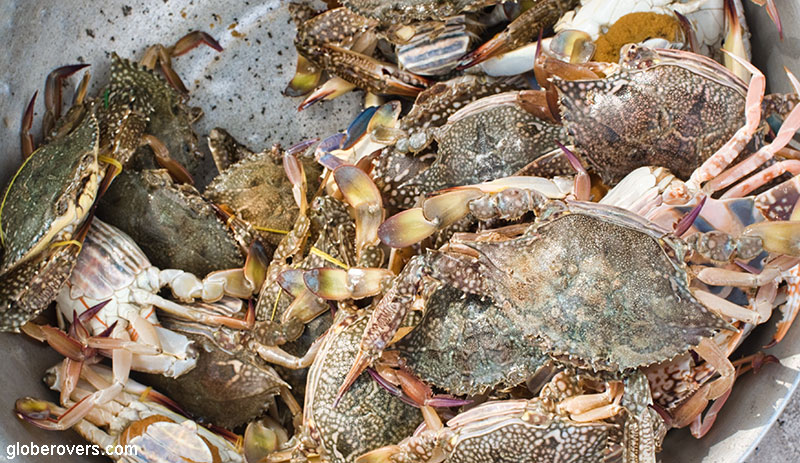

The town is built around the Kep National Park and while it doesn’t have abundant wildlife or untouched natural beauty, it offers many hiking paths through the dense jungle. Several viewpoints offer lovely vistas over the town and the nearby islands. Start the hike at the Led Zep Café, on a slope just past the southern park entrance above the Veranda Natural Resort. The café has a commanding view over the town.
While hiking, look out for Sunset Rock, Little Buddha, the Stone Horse, as well as monkeys and a few small waterfalls during the rainy season.

Among the other attractions in Kep is the statue of the Waiting Lady, known in the Khmer language as “sela cham bdei” which means “woman who waits for her man”. Sitting on a stone pedestal along Kep’s main beach, her exposed breasts and well-cushioned buttocks sporadically outrage the local social conservatives who then drape her statuesque “nude body” in cloth which often disappears in a day or two.
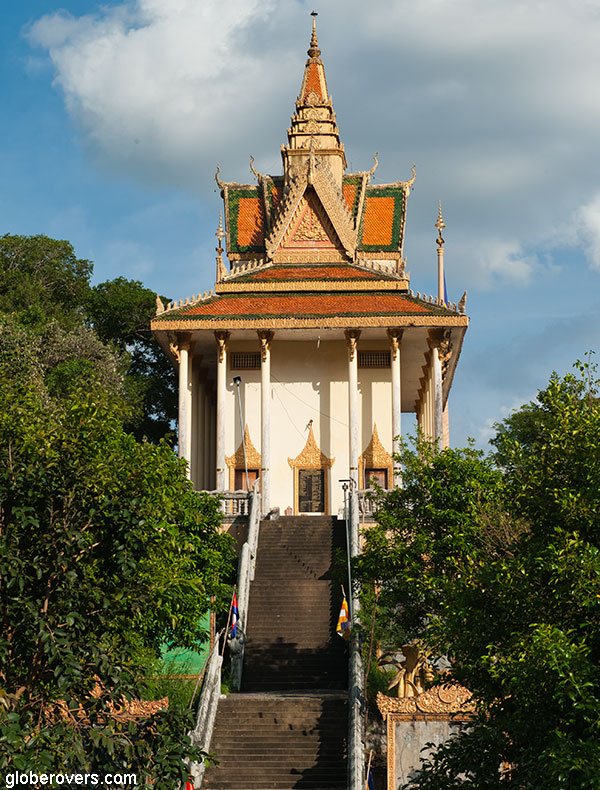

As should be expected of Kep, a giant statue in honour of the crabs sits on a table rising above the sea off the main beach. Among other attractions around town is a butterfly farm, Wat Samathi Pagoda, Samot Raingsey Pagoda, the Independence Monument, Kep Museum, and an Oceanarium run by the Marine Conservation of Cambodia.

An ideal spot by the beach from which to enjoy Kep’s breathtaking sunsets is The Sailing Club Restaurant & Bar. Set in a restored traditional wooden fisherman’s cottage, it offers a variety of cocktails, wines and beers, as well as an extensive menu of local seafood and tasty western favourites.
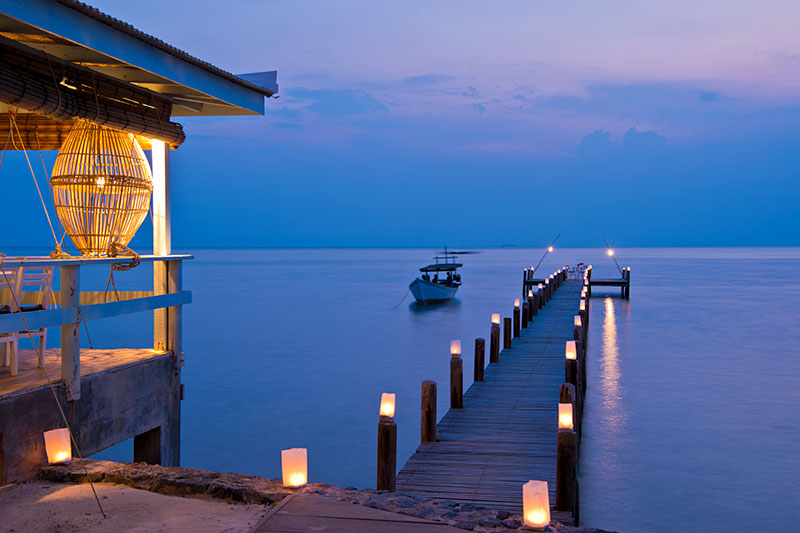
The sailing club belongs to the next door Knai Bang Chatt Resort. In the Khmer language, Knai Bang Chatt means “rainbow encircling the sun” and in Buddhism, this rainbow is the halo around Buddha’s head.
The resort’s buildings are historic. Its iconic Blue Villa once belonged to the governor of Kep while the resort’s reception building was owned by a relative of Cambodia’s King. The red Summer House was owned by the Head of Customs. Under the leadership of Francoise Lavielle, a French architect living in Phnom Penh, these buildings have been painstakingly restored to their original architectural grandeur.

Knai Bang Chatt is the perfect place to stay while visiting Kep. Don’t forget to enjoy their intimate spa that offers a range of treatments using only the best natural products, including aloe vera from their own organic garden.
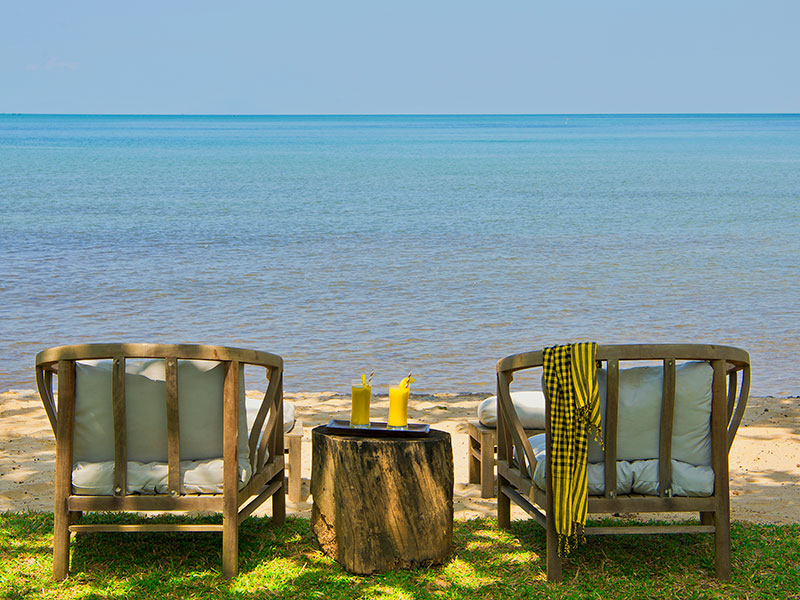
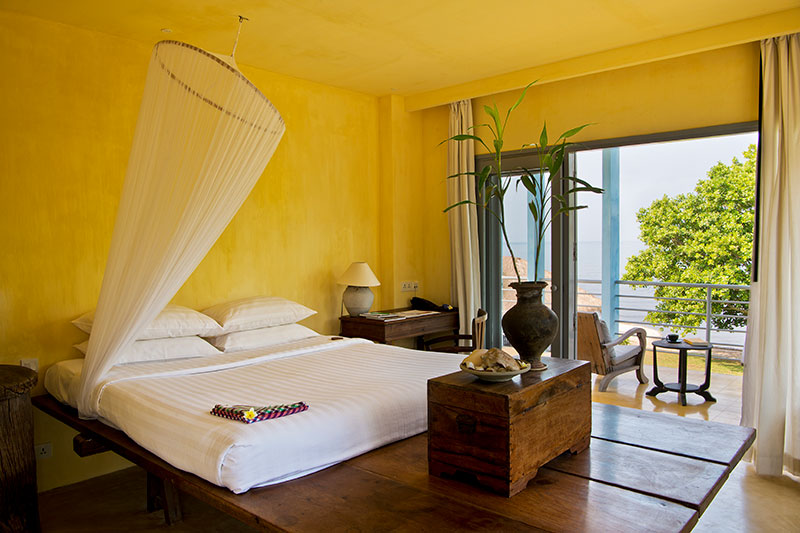
Kep’s Countryside
While Kep’s beaches are packed with locals during some weekends and holidays, the beaches to the west of town are mostly deserted. The tiny coastal dirt road is perfect for a day out on a bicycle or motorbike. Follow a few footpaths around the rice paddies to explore the small villages where a curious smile is waiting around every corner.
Outside Kep are large swathes of rice paddies, pepper farms and villages.
Follow in a northerly direction about 10 kilometres (6 miles) from Kep to reach a small group of pepper-producing farms. For decades, pepper from the Kampot and Kep regions has enjoyed a reputation as the world’s very best.

According to French historians, the chic Parisian restaurants in the 1930s used Kampot pepper exclusively. It is believed that the pepper derives its exquisite flavour from a combination of the mineral-rich soil of the region, the humid sea breeze and the bat guano harvested from the nearby limestone caves.
Some farms offer free tours of the process of growing and drying the peppercorns. Most have an on-site restaurant serving up delicious Cambodian and French fusion cuisine with fresh pepper as an essential ingredient. Among the plantations north of Kep that offer visitor’s tours are Sothy’s Farm, Ngovheng’s Farm, and Flying Dog Farm.
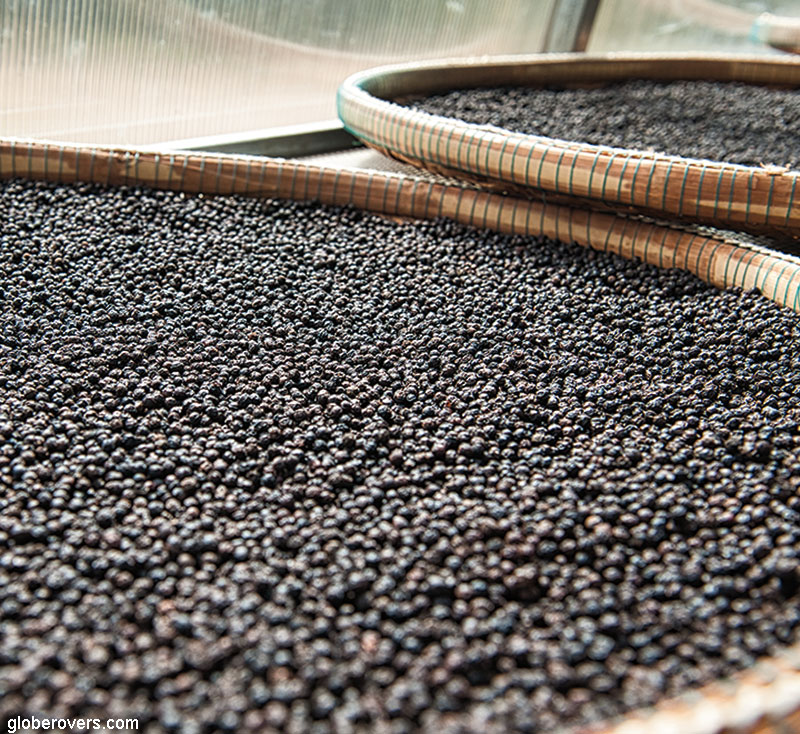
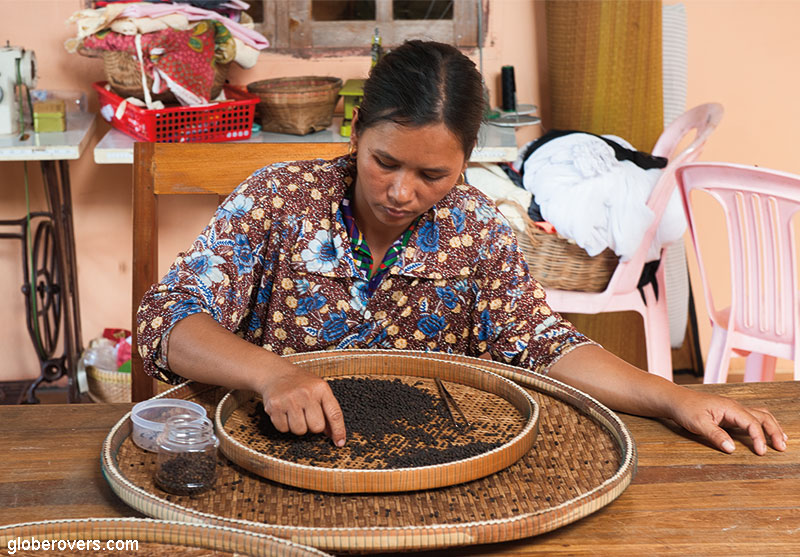
Further northwest is the popular La Plantation farm that sits on the edge of the Secret Lake, also known as Brateak Krola Lake. Local rumour abounds that this man-made dam did not get its “secret” connotation from its location, but rather from a belief that the evil Khmer Rouge had prisoners dig a secret mass grave for workers and fellow prisoners which was then flooded with water.
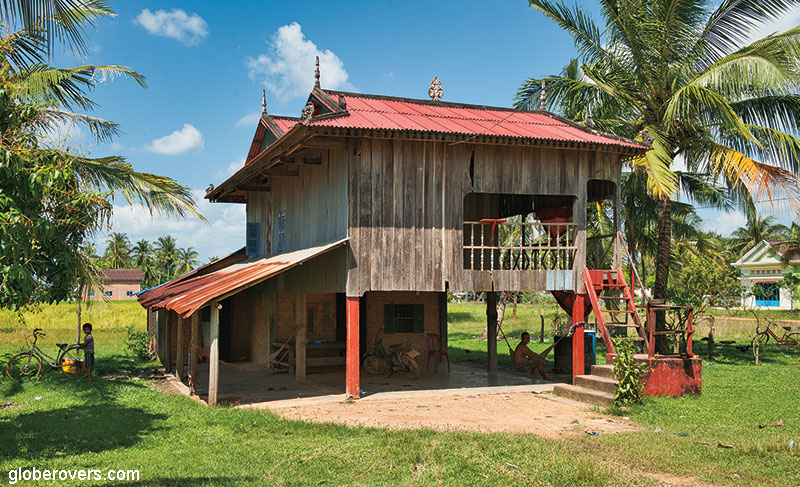
While no bodies have ever emerged from the depths, fishermen claim to have hooked human bones. Created under the Khmer Rouge as an irrigation dam, the lake is nestled between rising hills and rice paddies.
This area is studded with limestone rocks and a network of caves, many of which are home to Buddhist shrines.
Among the most prominent is Phnom Chhnork, a Hindu cave temple with pre-Angkorian carvings and a 7th century evocative shrine built from bricks and dedicated to Shiva, the God of Destruction.
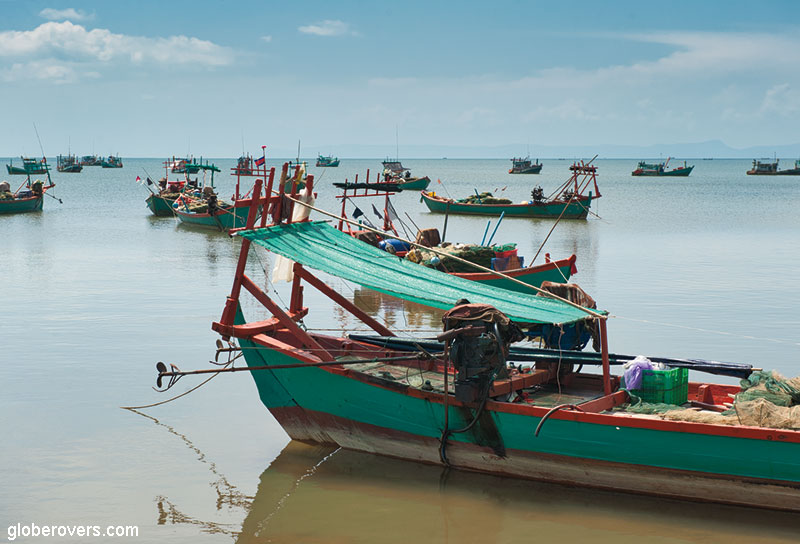
The pepper farms and caves can also be reached from Kampot town to the northwest of Kep. Along this road connecting these two towns are a few salt fields close to the sea. The fields are flooded with seawater and then blocked so the water can evaporate, leaving salt crystals which are then harvested, cleaned and iodized before being packaged and sold. The best time to visit is the dry season.
Kampot
Located 30 kilometres (19 miles) northwest of Kep along the Preaek Tuek Chhu River and close to the Elephant Mountains, the enchanting town of Kampot has a loyal following of travellers dating back decades. It is not hard to see why so many travellers have become entranced with this laidback riverside town, lined with dilapidated shophouses, restaurants, and guesthouses.
Located along a river, Kampot is known for its tranquility and outdoor activities.
Kampot served as the capital of the Circonscription Résidentielle de Kampot under French rule and for many years was Cambodia’s most important seaport. During the late 19th century, the French reported that Kampot was composed of several multi-ethnic communities, each with their own distinctive architecture.
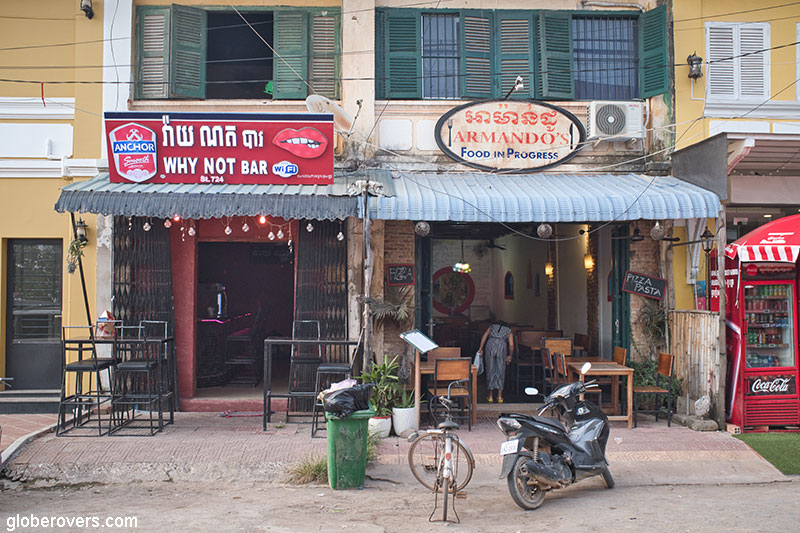
These enclaves included the Khmer (Cambodians), Chinese, Vietnamese, Malays, and of course the Europeans (mainly the French). The diverse and decaying architecture of today’s Kampot reflects the towns’ multi-cultural history.
Rent a bicycle and explore the fading pastel-coloured French colonial architecture with pockets of Southeast Asian buildings. Among the old colonial buildings that have been ever so tastefully restored to their former glory are the National Bank, Kampot Provincial Museum, and the Red Cross building.
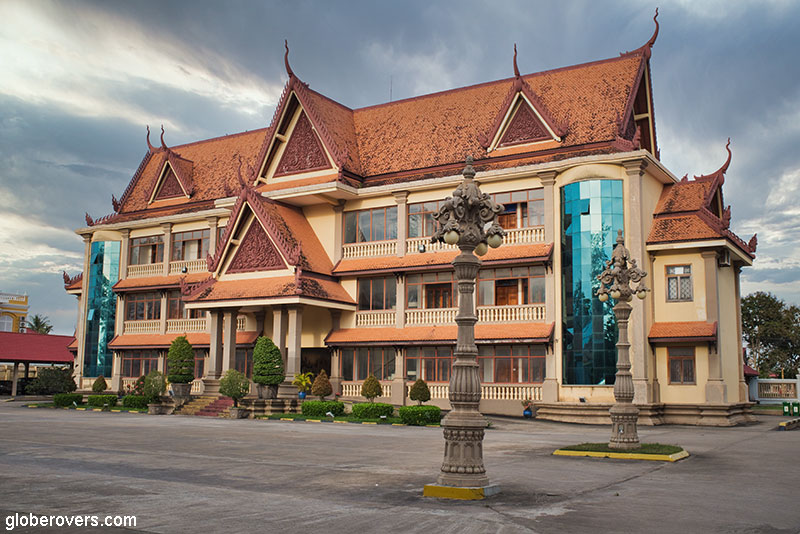
Don’t miss the Hotel Old Cinema with its distinctive pale-yellow art-deco facade. Built during the 1930s as the Maison de théâtre le Grandeur, it now is an upscale boutique hotel with a restaurant, outdoor swimming pool, bar, and a lovely garden.
Over the years, many travellers enjoyed the town so much that they stayed for the long term. The small but growing expat community is contributing to an expanding culinary variety and pub culture that did not exist prior to their arrival.

The town remains relatively untouched by tourism, especially during the low season. While it is considered largely safe, there has been an increase in crime against tourists and expats. The local government has been accused of dealing poorly with the threats against foreigners and covering up and even censoring media reports of the corruption among their police force.
The undeveloped river banks upstream from the town proper are sporadically interrupted by boutique resorts and backpacker retreats. Bungalows along the river banks offer a daily routine of swaying in a hammock with a beer in hand while watching the river slowly drifting down to the sea.

While Kampot has limited attractions in town, its variety of accommodation, restaurants, and bars make it an ideal base from which to explore the surrounding areas such as Bokor National Park, the cave temples, salt and pepper farms, lakes, and even day trips to offshore islands and the town of Kep.
Being on the edge of an estuary on the Kampong Bay River, the town is easily reached by boat from Kep, in addition to travelling by road. The popular “Crab Shuttle”, a converted local fishing vessel with a maximum load of eight people, departs daily on its 2.5-hour journey between Kep and Kampot. Kampot lies 85 kilometres (53 miles) east of the Sihanoukville International Airport.

Bokor National Park
The arched entrance of the Preah Monivong Bokor National Park is located just 10 kilometres (six miles) to the southwest of Kampot. Designated as an ASEAN Heritage Park, it covers an area of over 1,400 square kilometres (345,947 acres) with much of its plateau lying at over 1,000 metres (3,281 feet) above Kampot and the surrounding coast.
The old French hill station in the Bokor National Park is a gem to explore.
The park features waterfalls, exotic fauna and flora, remnants of abandoned French villas, a church, a rustic pagoda, and breathtaking vistas over the sea and the islands.
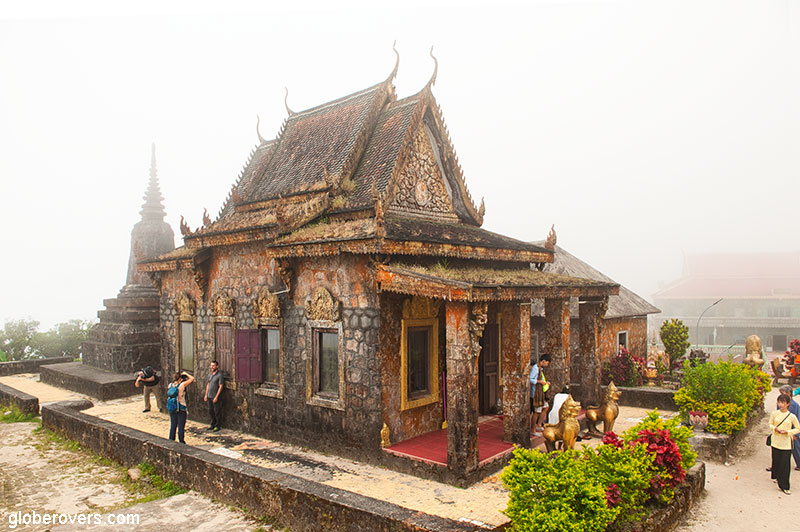
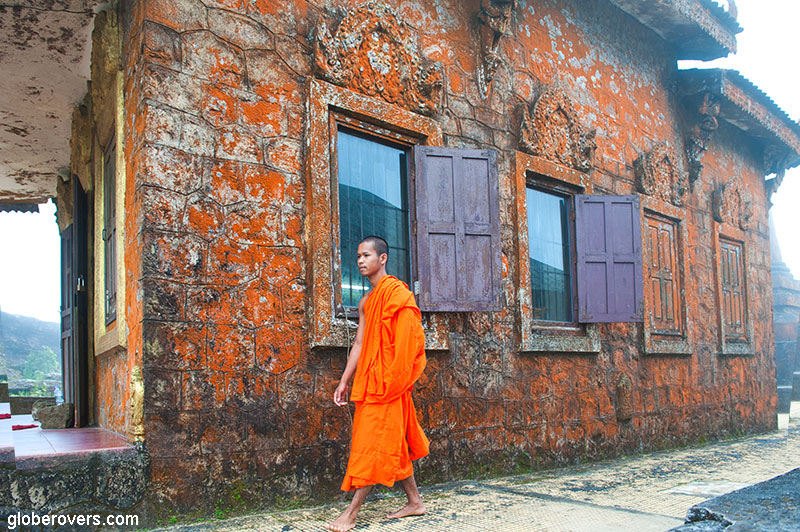
The park offers shelter to an incredible array of wildlife, including the clouded leopard, Asian black bear, muntjac (barking deer), banteng (wild cattle), gaur (Indian bison), sambar deer, wild boar, pileated gibbon, macaque, snake, fox, and many more species. While elephants and tigers might still be roaming here, no sightings have been reported for a while, so they may have moved on. The park is also home to over 300 bird species, including the great hornbill and the wreathed hornbill.
A relaxing day spent in the park may not result in any wildlife sightings as many are nocturnal and survive by roaming only in the remote parts of the park. Increased activity among poachers and the ever-present encroachment of humans are threatening the future of the park’s wildlife.
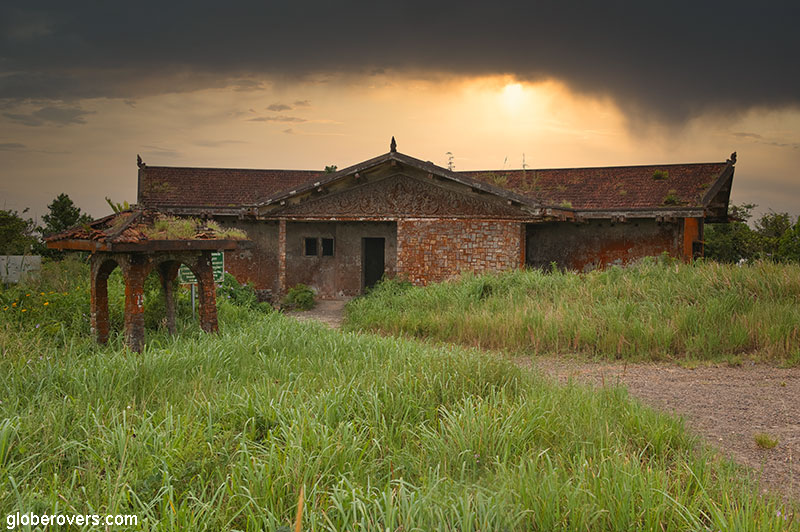
Except for avid and well-prepared wildlife spotters, most people visit the park to enjoy the cool misty air and to photograph the many abandoned buildings. The highlight of the park is Bokor Hill Station which was built by the French in the 1920s.
Among the many ruined buildings of the hill station still standing is the Old French Palace, a hauntingly beautiful old colonial building constructed by French settlers in 1917 and completed in 1925. It mainly served the French social elite who wished to escape the heat and humidity of Phnom Penh.
In later years the building was used as a casino and also served as a movie set for some Hollywood films. During the last few years, the building has been miraculously restored into a luxury hotel, a major disappointment to photographers looking for its rustic ruins.
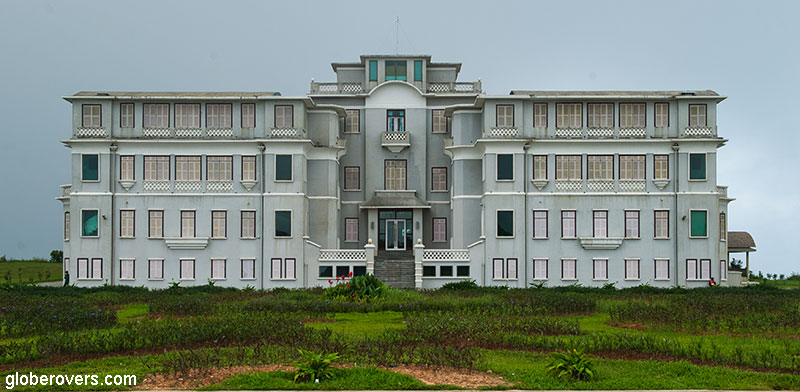
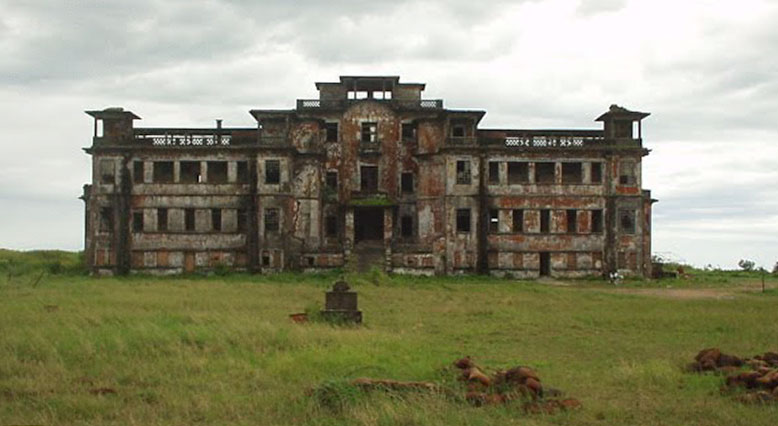
The plateau also offers ruins of old French colonial villas, as well as the beautiful rustic ruins of a large French Catholic Church that once accommodated Khmer Rouge soldiers.
There’s an eerie ghost town vibe when walking inside these ruins.
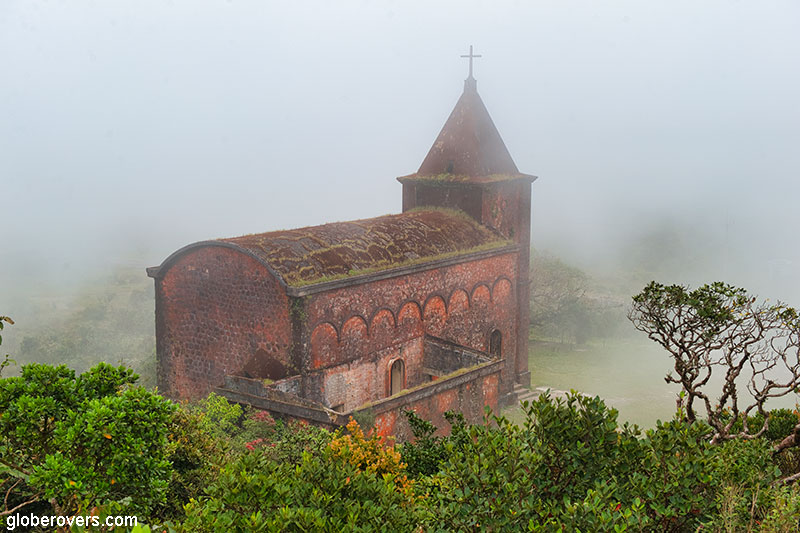
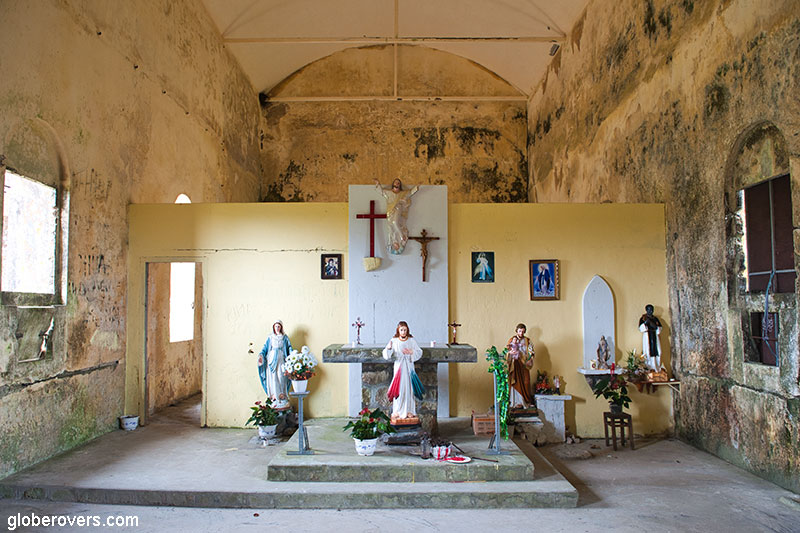
At any time of the day, in particular during the rainy season, the hilltop can be swathed in rolling clouds and visibility then drops to almost zero. Pouring rain often lasts only a short while and then clears up to blue skies within minutes.
One of the best experiences of visiting the park is biking or cycling up to the top of the hill. The distance by road from the main entrance to the highest vista point is about 12 kilometres (7.5 miles) as the crow flies, while the winding road is over 30 kilometres (19 miles) long. The road has been paved recently and is in great condition. Allow enough time to stop at several viewpoints to enjoy the serenity.

Sihanoukville and its Beaches
Sihanoukville, named in honour of former king Norodom Sihanouk, is Cambodia’s only deep-water port and gateway to the islands. Its international airport lies 20 kilometres (12 miles) to the southeast of town. While travellers from the capital, Phnom Penh, commonly choose the road or even the train, the airport offers international travellers more direct access to towns like Kampot and Kep, as well as the islands.
The best days of Sihanoukville and its nearby beaches are gone now!
The once sleepy beach town of Sihanoukville used to be popular among travellers. However, over the last few years, the town has been transformed by Chinese developers in a rather alarming way. The sheer speed at which massive hotels with casinos and skyscrapers are being constructed has angered locals and foreign visitors alike.
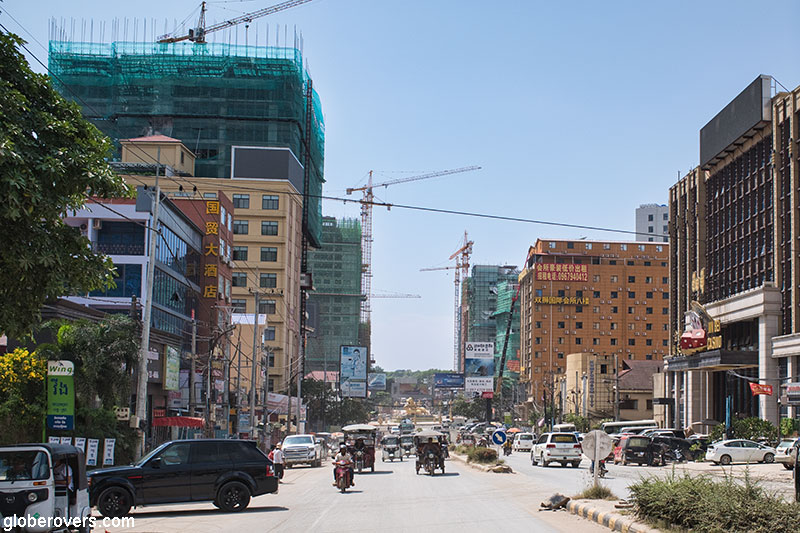
At present, the town is nothing but a vast Chinese-run construction site with more cranes towering above the buildings than can be counted. Sihanoukville has become a ballooning enclave for Chinese-run casinos despite gambling being banned in Cambodia. At latest count, the town is already home to over 100 casinos, many still unfinished. Even the streets are now lined with a majority of Chinese businesses and restaurants.
Chinese-language street signs are outnumbering those of any other language. Under the leadership of Prime Minister Hun Sen, the Cambodian government’s embrace of China’s take-over of Sihanoukville is nothing short of selling out this part of Cambodia to China.
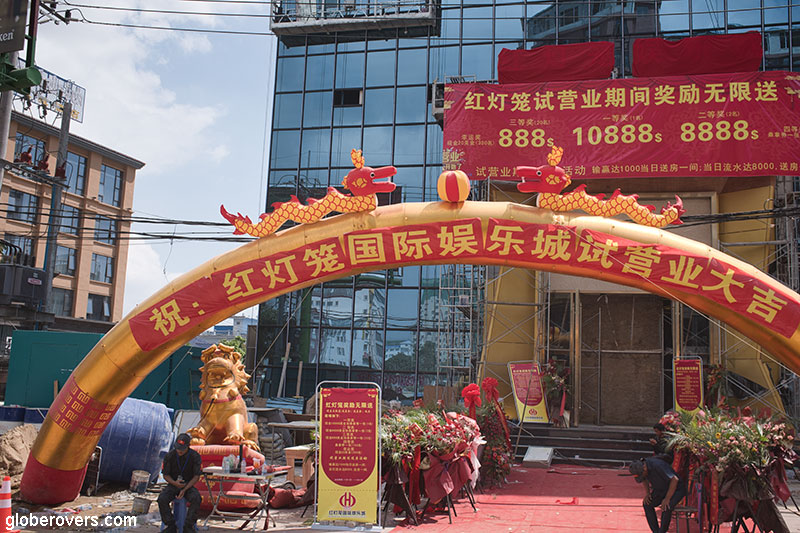
Since China’s take-over of Sihanoukville, the town has lost all of its charm and is best avoided by travellers who now only use the town’s ports to reach the islands. However, Chinese developers are also encroaching on the islands.
At one of the most beautiful beaches at Clear Water Bay on Koh Rong Sanloem, the developers have already moved in with earth-movers to clear large swathes of the jungle in preparation for the construction of a resort.
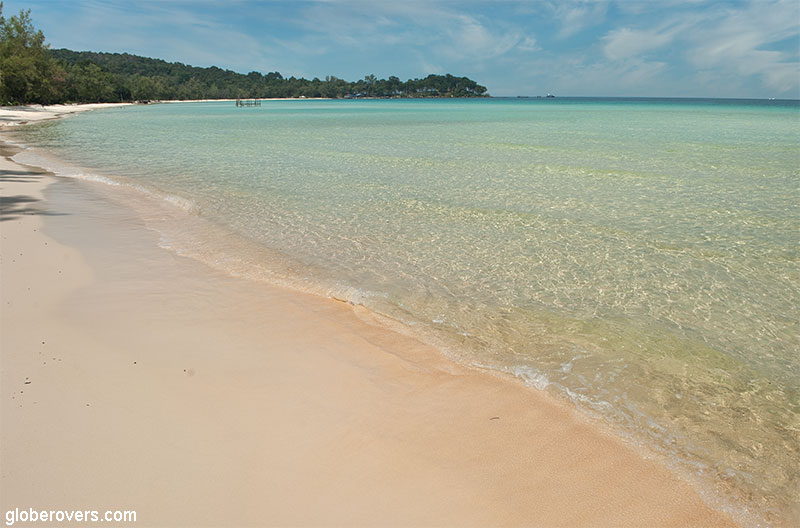
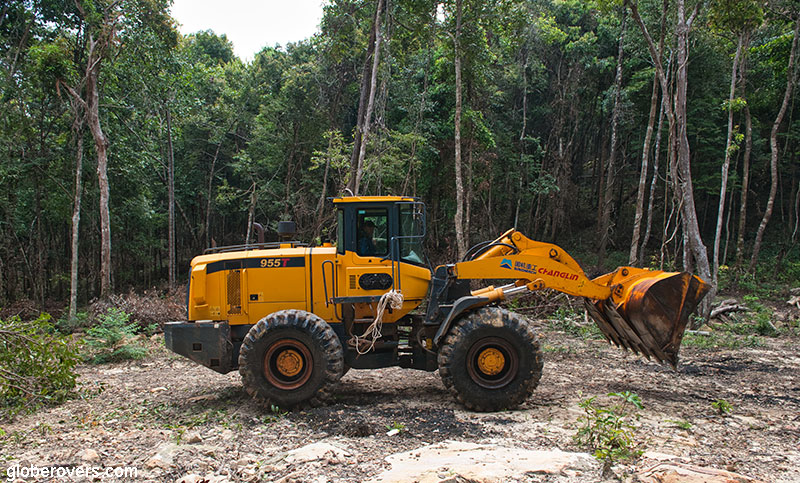
On the southeastern outskirts of town are Ochheuteal Beach, followed by Otres Beach further south. Up until a few years ago before the Chinese developers arrived, these beaches were locally managed and offered peaceful rustic beach bungalows popular among backpackers.
The accommodation and bar scene on both beaches are now going through a metamorphosis with an increasing number of old and newly constructed establishments under Chinese ownership. As with Sihanoukville, these beaches are now best avoided by international travellers.
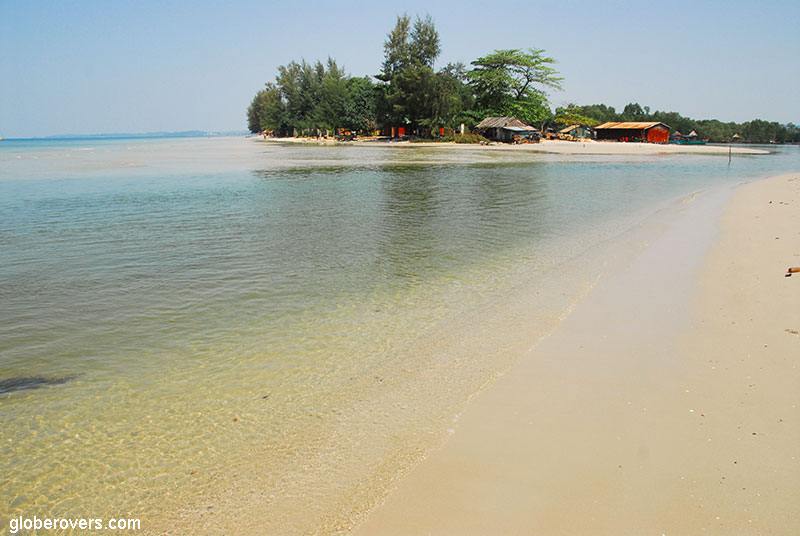
About 17 kilometres (10 miles) north of downtown Sihanoukville is the Kbal Chhay Waterfalls. The water flows from several sources along the mountain range, although only three of these sources are visible.
☛ Read more: 4 Most Idyllic Islands – 11 Best Beaches of Cambodia
The waterfall, which is 14 metres (46 feet) high, is at the point where these three sources join. The best time to visit is during the rainy season between June to October.
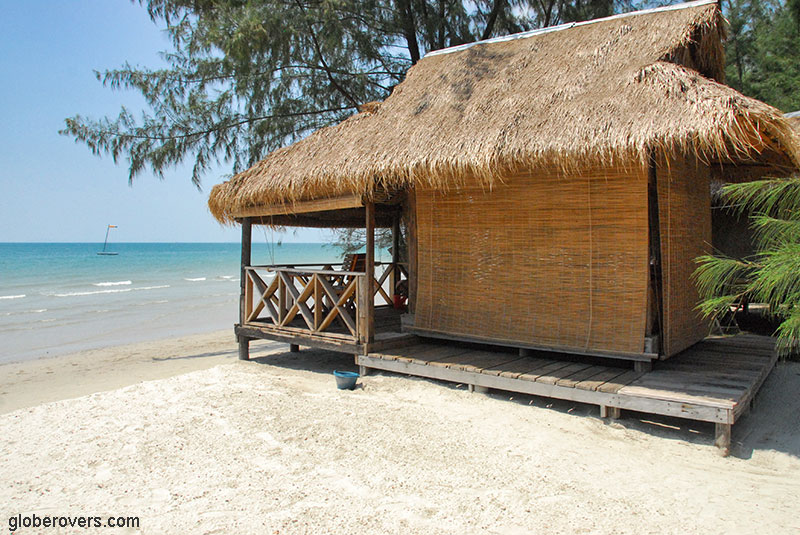

Essential Information
Getting There
The gateway to Cambodia’s south is the town of Sihanoukville and its nearby International Airport. From the airport, it is easy to reach the southern towns and islands via the port in Sihanoukville. From the capital, Phnom Penh, buses, minibuses, and taxis take about 5 hours to reach Sihanoukville, 230 km (143 mi) to the southeast. Trains take 7.5 hours.
Getting Around
Buses between Sihanoukville, Kampot and Kep can be slow and uncomfortable. Public transport from the airport is very limited. Most routes are best travelled by taxis booked through apps: Grab and PassApp. Between Kep and Kampot, hop on the Crab Shuttle boat for a pleasant, but slow ride. On the islands use boats or motorbike taxis.
Photography
Photographers come to Cambodia to capture the palm-fringed white-sand beaches with turquoise water, authentic fishing villages, abandoned villas and beautifully restored colonial buildings, as well as the people in their daily lives who are generally happy to have their photos taken
When to Go
The best time to visit southern Cambodia is during the dry season between November and April. High season is from mid-November to the end of January, with more expensive accommodation and limited rooms. May and October can be very nice while June to August can be very wet.
Where to Stay
While much of the accommodation in southern Cambodia is backpacker to mid-priced bungalows and huts, there is no shortage of luxury resorts for those who want to splurge. Consider Knai Bang Chatt luxury boutique resort in Kampong, and The Royal Sands on Koh Rong island.
Safety
The south of Cambodia is quite safe and free of landmines. Like everywhere else, be alert for pickpocketing, overcharging and scams, although these are rarely reported. When cycling, be careful with valuables in the carry basket, in particular in Kampot.
Dining Out
In all of the south, Kampot has the biggest variety of restaurants including Khmer and European. Seafood is popular, particularly in Kep where crabs with local peppercorns are a must-try dish. On the islands, except in the luxury resorts, the food is quite basic and Thai dishes are common.
Train Travel
A regular passenger train service between Phnom Penh and Sihanoukville, with a stop in Kampot, commenced in May 2016. There is one train a day on Fridays and Saturdays and two on Sundays. It takes around 7 hours 30 minutes to travel the 264 km (164 mi). Trains leave Phnom Penh in the early morning or late afternoon and cost US$7 one way.
Cost of Travel
The cost of travel in Cambodia obviously depends on how much you want to spend. Accommodation varies from US$7 per night for a tent on the beach, to US$5,000 dollars in a luxury resort. Generally, the cost is similar to Vietnam, cheaper than Thailand, but not as cheap as Laos.
☛ Read more: Blog posts of Cambodia



Blog post and photos by Peter who has been travelling almost full-time since 2005 and has been to over 122 countries. He visited several countries, such as Japan, more than 20 times. Peter is Editor-in-Chief and Publisher of GlobeRovers Magazine, an independent travel magazine focused on intrepid destinations.
